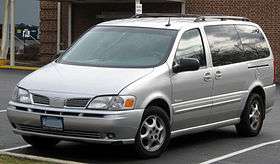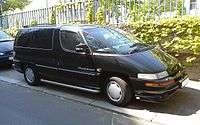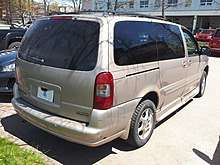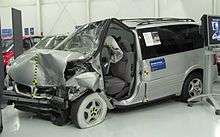Oldsmobile Silhouette
The Oldsmobile Silhouette is a minivan which was produced by General Motors for model years 1990 through 2004. Production was ceased as a direct result of General Motors discontinuing the Oldsmobile brand in 2004. The Silhouette was replaced by the Saturn Relay and the Buick Terraza for the 2005 model year.
| Oldsmobile Silhouette | |
|---|---|
 | |
| Overview | |
| Manufacturer | General Motors |
| Production | August 1, 1989–March 31, 2004 |
| Model years | 1990–2004 |
| Body and chassis | |
| Class | Minivan |
| Platform | U-body |
| Related | Pontiac Trans Sport Pontiac Montana Opel Sintra Chevrolet Venture |
| Chronology | |
| Predecessor | Oldsmobile Custom Cruiser |
| Successor | Saturn Relay Buick Terraza |
Background
General Motors' first attempt at producing a minivan to compete with the Chrysler minivans, the rear wheel drive, truck-based Chevrolet Astro and its twin, the GMC Safari failed to make a noticeable dent in Chrysler's near monopoly of the minivan market in the 1980s, so this second attempt was made. The 1989 Oldsmobile Silhouette and its sibling models, while more successful than the Astro/Safari due in terms of market share, had unconventional "Dustbuster" styling that ultimately limited its appeal and sales.
Original concept
First shown to the public in 1986, the Trans Sport concept car featured futuristic styling, individually removable bucket seats with built-in stereo speakers, a gull-wing rear passenger door and extensive use of glass including a glass-paneled roof.
The Pontiac Trans Sport was subsequently approved for production without he gullwing door and the glass roof. Chevrolet and Oldsmobile received production vehicles based on the Trans Sport with the Lumina APV and Silhouette respectively.
First generation (1990-1996)
| First generation | |
|---|---|
 | |
| Overview | |
| Also called | Pontiac Trans Sport (Europe, 1994-1997) |
| Production | August 1, 1989–May 17, 1996 |
| Model years | 1990-1996 |
| Assembly | North Tarrytown Assembly, North Tarrytown, New York, United States |
| Body and chassis | |
| Body style | 3-door minivan |
| Layout | Transverse front-engine, front-wheel drive |
| Platform | U-body/GMT199 |
| Related | Pontiac Trans Sport Chevrolet Lumina APV |
| Powertrain | |
| Engine | 3.1 L LG6 V6 3.4 L LA1 V6 3.8 L L27 V6 |
| Transmission | 3-speed 3T40 automatic 4-speed 4T60-E automatic |
| Dimensions | |
| Wheelbase | 109.8 in (2,789 mm) |
| Length | 1989–93: 194.2 in (4,933 mm) 1994–96: 194.7 in (4,945 mm) |
| Width | 1989–93: 73.9 in (1,877 mm) |
| Height | 1989–91: 65.2 in (1,656 mm) 1992–96: 65.7 in (1,669 mm) |
| Curb weight | 3,599 lb (1,632 kg)—3,899 lb (1,769 kg) |
.jpg)
The very first 1990 Oldsmobile Silhouette rolled off the assembly line on August 1, 1989. Assembled in General Motors' now-closed North Tarrytown Assembly assembly facility, these U platform vans consisted of a galvanized steel space frame wrapped in composite plastic body panels that were impervious to rust and minor dents and dings, a manufacturing technique developed on the Pontiac Fiero and also used extensively on General Motors' Saturn line of vehicles.
The Silhouette was available with seating for seven, with the five lightweight (34 lb (15 kg)) rear seats being individually reconfigurable and removable. In 1994 built-in child seats were added to the option list, which provided the ability to switch two of the rear seats between adult and child seating with the pull of a seat-mounted tab.
Included with the level ride package, which utilized a compressor and air-pressurized rear shock absorbers to maintain vehicle height regardless of load, was a control panel and air hose kit that allowed the vehicle to be used to inflate tires, air mattresses, sporting equipment and such.
In 1994, a remote-controlled power sliding door feature was added, a General Motors innovation.
For the 1994 and 1995 model years, traction control was available with the 3800 engine option.
The first generation Silhouette was not available in Canada.
Europe
Europeans grew accustomed to sleek minivans thanks to the Renault Espace and did not object to the futuristic styling. For the European market however, the Oldsmobile Silhouette was sold as the Pontiac Trans Sport by replacing the Oldsmobile badging with Pontiac badging, along with Pontiac wheels. Sales in Europe were good for an American import, but did not represent enough volume to make a fourth, distinct model economically feasible. The Pontiac Trans Sport of Europe was discontinued in 1997. Its successors were both the Chevrolet Trans Sport (Second gen Pontiac Trans Sport rebadged as a Chevrolet) (LWB), and the Opel Sintra (SWB). In the United Kingdom, it was sold as the Vauxhall Sintra.
 European Pontiac Trans Sport (Front).
European Pontiac Trans Sport (Front)._rr.jpg) European Pontiac Trans Sport (Rear).
European Pontiac Trans Sport (Rear).
Engines
Modest sales success
The design of these minivans was controversial. At the time that the Oldsmobile Silhouette and its siblings were conceived, no one had tried to market a stylish or sporty minivan, and GM felt that this represented a potentially large market segment. They styled these minivans to be lower and sleeker than the competing brands. The extremely large, long and sloped windshield and the resultant long distance to the base of the windshield when sitting in the drivers seat made for a disconcerting driving experience until a person could adjust to the "different" proportions. Automotive magazines christened the new minivans "dustbuster" after a household appliance with a similar profile.
The first engine in these vans was a meager 3.1 L V6, that produced only 120 hp (89 kW), which was not up to the task of hauling these fairly heavy vehicles.
In 1992, the Silhouette and its siblings received the 170 hp (127 kW) 3.8 L 3800 V6 as an option, which provided better torque and acceleration, making them the most powerful as well as best handling minivans then in production.
Production of first generation Silhouettes and stablemates ended in 1996, at which time the Tarrytown, NY plant which produced them and which had been in operation since 1900, was shuttered and scheduled for demolition. The final 1st generation U-body Oldsmobile Silhouette rolled off the assembly line on May 17, 1996.
Year to year changes
.jpg)
- 1990 - All new model- The Silhouette in keeping with its positioning as GM's luxury minivan offering is available with optional leather seating, a feature not available on its platform mates and available only on the Chrysler Town and Country among competing manufacturer's models.
- 1991 - Customer complaints regarding glare reflected on the interior of the windshield from the massive expanse of dashboard lead to the addition of black carpeting in lieu of the more reflective plastic used in the previous year.
- 1992
- Newly available for 1992 was GM's 3800 V6 engine coupled with a Hydra-Matic 4T60-E 4-speed electronically controlled automatic transmission.
- The cowl-mounted fixed radio antenna was eliminated, and an integrated roof antenna was installed, sandwiched between the roof and the headliner.
- Side view mirrors were changed to the folding type, and were enlarged to provide better rear visibility.
- Brakes were enlarged and anti-lock brakes (ABS) were added as standard equipment.
- A pop-up sunroof was added to the options list.
- Steering wheel-mounted controls for the stereo system were added as an option.

- 1993
- The Silhouette's exterior is facelifted, sporting wrap-around turnsignal/parking lamps in front, along with standard foglamps.
- Tail lights' design is changed from a grid to a solid red color with black "dissolves" around the edges, a style that had been used exclusively on the Pontiac Trans Sport previously.
- A remote controlled power sliding side door was announced for 1993, but failed to actually make it into production.
- A redesigned center console was added this year with revamped, larger climate controls, a large storage cubby and a large storage bin at its base.
- 1994
- In an effort to lessen the perceived distance to the base of the windshield, a ridge was added to the interior dash finishing panel.
- A remote-controlled power sliding door became available as an option.
- Built-in child seats for the second row became available as an option.
- A traction control system became available as an option.
- Rear deep-tinted windows now featured a darker tint than previously used.
- A driver's side airbag became standard equipment.
- A roof rack became standard on all Silhouettes and their subsequent model years, but remained optional on the Chevrolet and Pontiac.
- 1995
- Automatic power door locks that engaged/disengaged with the transmission shifting into or out of "park" added as a standard feature of the power door lock option package.
- 1996
Second generation (1997–2004)
| Second generation | |
|---|---|
 | |
| Overview | |
| Production | August 6, 1996–March 31, 2004 |
| Model years | 1997-2004 |
| Assembly | Doraville, Georgia, United States |
| Body and chassis | |
| Body style | 3-door minivan 4-door minivan |
| Layout | Transverse front-engine, front-wheel drive / all-wheel drive |
| Platform | U-body/GMT200 |
| Related | Pontiac Trans Sport Chevrolet Venture Pontiac Montana Buick GL8 Opel Sintra Vauxhall Sintra Pontiac Aztek Buick Rendezvous Buick Terraza |
| Powertrain | |
| Engine | 3.4 L LA1 V6 |
| Transmission | 4-speed 4T65-E automatic |
| Dimensions | |
| Wheelbase | SWB: 112.0 in (2,845 mm) LWB: 120.0 in (3,048 mm) |
| Length | SWB: 187.4 in (4,760 mm) LWB: 201.4 in (5,116 mm) |
| Width | 72.2 in (1,834 mm) |
| Height | SWB: 67.4 in (1,712 mm) LWB: 68.1 in (1,730 mm) |
| Curb weight | 3,710 lb (1,680 kg)—3,832 lb (1,738 kg) |
The redesigned 1997 Silhouette was built at Doraville Assembly. The first 1997 Silhouette rolled off the assembly line on August 6, 1996. Canadian sales began as a 1998 model. Unlike the Venture and Trans Sport/Montana, the roof rack was standard on all Silhouettes. GM continued to offer the Silhouette as their premium luxurious minivan, the Montana as the sporty one, and the Venture as the basic version. The base model (only offered for 1997) was the only model to offer short-wheelbase and a driver side sliding door being only optional, when all the other trim levels of the Silhouette were in long-wheelbase extended version and offered a standard driver side sliding door.
Having achieved second place in sales to Chrysler, General Motors brought out an entirely new U platform series of minivans, theoretically based on the lessons learned from its previous mis-steps. Still stinging from the criticism of the "dustbuster" minivans, the new Silhouette would be completely conventional in all respects. The vehicle would be of steel unibody construction, and styling would be as conservative as possible. The previous generation was a little too large for comfortably navigating European streets, so this new range of models would be narrower and slightly smaller than was the norm for the United States in order to produce a single range of minivans that GM hoped would fill the needs of both the North American and European markets.
New for this generation, cabin air filters were installed, and the filters can be accessed from behind an access panel easily accessed from inside the glove compartment.
During the development of this generation of the U-body minivan, General Motors extensively benchmarked the then current Chrysler minivans. The resultant vehicles more closely resembled the immensely successful trio of Chrysler minivans; However, Chrysler would launch a completely redesigned minivan line a year before GM.


Two different wheelbase lengths were offered as well as dual sliding doors. Silhouettes, in keeping with their luxury positioning, offered many features as standard that were optional on competing makes and on its platform mates. In 1998, it became one of the first vehicles on the market to offer a VCR with overhead retractable LCD screen for back seat viewing, which has since become a "must-have" option for families with children. For 2001, the Silhouette received a minor facelift that included a new grille and front bumper.
Trim levels
- base - 1997
- GL - 1997–2004 Included: Cloth upholstery, 15" steel rims with hubcaps, air conditioning, map pockets in driver and passenger seats, power driver's seat, storage drawer under passenger front seat, an AM/FM stereo with single-CD player and seek-scan tuning , coaxial speakers, and clock, overhead console, fog lamps, and power front windows with automatic driver's side window. Later standard features were an AM/FM stereo with single-CD and cassette players and speed-compensated volume control, TheftLock, and clock, a garage door opener, rear seat audio controls, keyless entry, heated power mirrors, and automatic headlamps.
- GLS - 1997–2004 Added: leather upholstery, rear parking aid, tri-zone climate control system, rear seat audio/climate controls, compass, garage door opener, an AM/FM stereo with single-CD and cassette players, seek-scan tuning, coaxial speakers and clock, leather wrapped steering wheel with audio controls, power front seats with driver's side memory, 16" alloy rims, and power sliding passenger door.
- GS - 1998–1999
- Premiere - 1998–2004 Added: Entertainment system with DVD player with fold-down overhead color monitor for rear passengers, input jacks for video games or camcorders, 4 pairs of wireless headphones and rear seat visual/audio controls, heated front seats, and power sliding driver's side door.
Engine
3.4 L LA1 3400 (207 cu in (3.4 L)) V6
Safety

The minivan received a "Poor" rating by the Insurance Institute for Highway Safety. Some comments made by the IIHS after the first test in 1997 were:
- Major collapse of the occupant compartment left little survival space for the driver.
- Extreme steering wheel movement snapped the dummy's head backward.
- The unnatural position of the dummy's left foot indicates that an occupant's left leg would have been seriously injured in a real-world crash of this severity.
- The forces on the left lower leg were so high that the dummy's metal foot broke off at the ankle.
The National Highway Traffic Safety Administration gave the van 4 stars for driver protection and 3 stars for passenger protection in the 35 mph (56 km/h) frontal impact test. In the side impact test, it received 5 stars for front passenger protection, and 5 stars rear passenger protection.
The safety issues of the Silhouette and other second generation U-body minivans were addressed with the third generation redesign, which earned the highest rating of "Good" given by the Insurance Institute in the frontal offset crash test.
Mixed sales success
The Silhouette and its platform mates achieved slightly better sales than their avant-garde predecessors, but also failed to capture a significant share of the market. The Silhouette was a close competitor in many of the categories deemed of importance, but was a winner in luxury, first in the world to offer factory video screen, the minivan market had become significantly more crowded with competing products that proved to be more desirable and throughout its production it was widely considered a second-tier competitor, certainly competent but not a stand-out in any category.
The Silhouette remained in production until the 2004 model year with minimal changes. The Oldsmobile division of General Motors was shut down and no Oldsmobiles were produced after the 2004 model year. The final Oldsmobile Silhouette rolled off the assembly line on March 31, 2004.
The spiritual successor to the Oldsmobile Silhouette within the General Motors lineup is the Buick Terraza (2005-2007), which was built on an updated version of the U platform and occupied the luxury minivan slot previously occupied by the Silhouette. Due to poor sales of all the third-generation GM minivans, GM decided to exit the minivan market altogether. Production of the Buick Terraza and Saturn Relay ended after the 2007 model year and for the Chevrolet Uplander, production ceased in the United States after the 2008 model year and focused on the new crossover vehicle market. However, production of the Uplander continued on for one more year (along with the Pontiac Montana SV6) in Mexico and Canada due to slightly better sales in those countries. Had the Oldsmobile division not been discontinued it would be likely that the Silhouette would have been kept for the third generation of the GM minivans.
References
External links
| Wikimedia Commons has media related to Oldsmobile Silhouette. |
- Official Oldsmobile Silhouette website (last updated in 2004)
